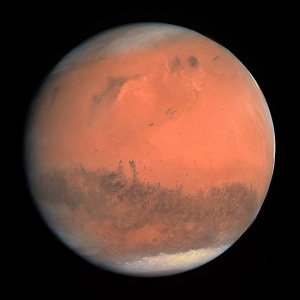Mars

Mars is the fourth planet from the Sun and the second-smallest planet in the Solar System, after Mercury. Named after the Roman god of war, it is often referred to as the "Red Planet", because the iron oxide prevalent on its surface gives it a reddish appearance. In different cultures, Mars represents masculinity and youth. Its symbol, a circle with an arrow pointing out to the upper right, is used as a symbol for the male gender.
The many failures in Mars exploration probes resulted in a satirical counter-culture blaming the failures on an Earth-Mars "Bermuda Triangle", a "Mars Curse", or a "Great Galactic Ghoul" that feeds on Martian spacecraft.
Of all the planets in the Solar System, the seasons of Mars are the most Earth-like, due to the similar tilts of the two planets' rotational axes. The axial tilt of Mars is 25.19 degrees relative to its orbital plane, which is similar to the axial tilt of Earth. Mars has the largest dust storms in the Solar System. These can vary from a storm over a small area, to gigantic storms that cover the entire planet. They tend to occur when Mars is closest to the Sun, and have been shown to increase the global temperature.
The existence of Mars as a wandering object in the night sky was recorded by the ancient Egyptian astronomers and by 1534 BCE they were familiar with the retrograde motion of the planet By the period of the Neo-Babylonian Empire, the Babylonian astronomers were making regular records of the positions of the planets and systematic observations of their behavior. For Mars, they knew that the planet made 37 synodic periods, or 42 circuits of the zodiac, every 79 years.
Mars, the God of War, is the ruler of Aries. In astrology, Mars is the planet of energy, action, and desire. It is the survival instinct, and can be thought of as the animal nature of man. [1]
References

